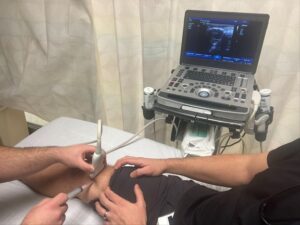Today on the emDOCs cast with Brit Long, MD (@long_brit), we cover human immunodeficiency virus (HIV) and acquired immunodeficiency syndrome (AIDS).
Episode 46: HIV
Background
- HIV is a retroviral infection that affects CD4 T cells. Blood transfusion is highest risk but rare in the U.S. today. Receptive anal intercourse and injection drug use with needle sharing are other means of transmission.
- AIDS occurs in a HIV+ patient with a CD4 count < 200.
- Indicators include pulmonary/disseminated TB, esophageal candidiasis, cryptococcosis, CMV retinitis, Kaposi sarcoma, MAC, PCP pneumonia, PML, HIV encephalitis or wasting syndrome, and many others.
- Up to 15% of patients infected with HIV are unaware of their diagnosis.
Acute Retroviral Syndrome:
- Acute retroviral syndrome: syndrome marked by widespread viral dissemination and high infectivity.
- Often misdiagnosed as the flu or mononucleosis.
- Occurs 2-4 weeks after initial infection, lasts for less than 14 days.
- Symptoms include fever, fatigue, sore throat, rash, headache, lymphadenopathy.
Evaluation/Testing:
- Testing: antigen/antibody assay plus viral load.
- After 10-15 days, viral RNA levels peak, CD4 count drops briefly.
- Antigen becomes positive after 2 weeks.
- P24 assays rise with viral loads, with sensitivity between 90-100%. Rises 5 days after infection.
- After the acute infection, CD4 levels begin to rise but do not return to initial baseline prior to infection.
- Negative HIV screening and negative viral load can exclude HIV, but if suspicious, repeat testing in several weeks.
- If negative HIV screening and positive viral load, this means early infection is present. Repeat test, as this could be a false positive.
- Positive screening and positive viral load means early or established HIV infection. If antibody only test is negative, then early HIV is likely.
- If suspicious of HIV or confirmed diagnosis, follow up with ID is vital. Antiretroviral therapy saves lives.
- Labs: Mild anemia, elevation in LFTs, thrombocytopenia.
Opportunistic Infections
- Risk of opportunistic infections depends on CD4 count.
- CD4 > 500: Opportunistic infections rare; most infections resemble those of patients with fully functioning immune systems.
- CD4 200-500: Kaposi sarcoma, candidiasis, HSV, zoster, bacterial infections
- CD4 < 200: PCP, encephalopathy, TB, CMV, drug fever, endocarditis, lymphoma, PML, histoplasmosis
- CD4 < 100: toxoplasmosis, cryptococcus, cryptosporidium
- CD4 < 50: CMV retinitis, CNS lymphoma, MAC
- CD4 counts can be estimated using absolute lymphocyte count: < 1000 predicts CD4 counts < 200. > 2000 predicts CD4 count > 200.
- Sources of infection – LUCAS (B): lungs, urine, CNS, cardiac, abdomen, arthritis, spine, spine and soft tissue, bacteremia
- Most common sources of infection in HIV patients are those infections that affect other patients.
- CD4 count less than 200 associated with different infections.
- PCP is one of the most common infections affecting HIV patients.
- PCP presents with fever, dry cough, progressively worsening shortness of breath, often over weeks.
- LDH typically 2-3 times higher than normal. Chest x-ray will demonstrate symmetric interstitial infiltrates or ground glass opacities.
- Treatment is trimethoprim-sulfamethoxazole. If allergic, primaquine or clindamycin may be used. Pentamidine is associated with hypotension and hypoglycemia but can be used as another alternative.
- If room air oxygen saturation < 90%, room air PaO2 < 70 mm Hg, or A-a gradient > 35 mm Hg, should receive steroids.
- Cryptococcus: budding yeast, most common CNS infection in HIV/AIDS.
- Recurrent headaches over weeks, elevated ICP with seizures and altered mental status in severe disease.
- CT head often normal. LP is diagnostic with elevated opening pressure. Cryptococcus antigen and culture are highly accurate.
- Treatment is amphotericin B and flucytosine.
- Toxoplasmosis: parasite, most common cause of focal encephalitis in HIV/AIDS, multifocal CNS lesions.
- CT head without contrast will demonstrate subcortical lesions. CT with IV contrast will demonstrate ring-enhancing lesions.
- Treatment is pyrimethamine plus sulfadiazine or clindamycin or azithromycin. Trimethoprim-sulfamethoxazole may also be used.
- Other infections: EBV lymphoma, TB, PML. Lesions may obstruct CNS flow and cause herniation.
- CNS infections usually present in those with CD4 count < 100. Patients with counts < 200 are usually on prophylaxis with trimethoprim-sulfamethoxazole.
- GI infections can cause significant nausea, vomiting, diarrhea.
- Salmonella, Campylobacter, Yersinia, Shigella, C. difficile, Isospora, Cryptosporidium, MAC, CMV.
- Oral thrush and esophagitis: most commonly due to candidiasis. May occur due to HSV, EBV, and CMV.
Immune reconstitution inflammatory syndrome (IRIS):
- Disease with inflammatory response in those with HIV after starting antiretroviral therapy or a change to more active therapy.
- Patients most commonly have low CD4 counts and high viral loads when therapy is started.
- May occur at any CD4 count, usually 4-8 weeks after starting therapy.
- Mild IRIS: supportive therapy, continue antiretroviral therapy, treat any opportunistic infections.
- Severe IRIS: may result in permanent disability, treat with steroids, inpatient admission.







